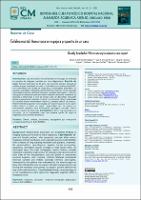Cefalea mortal: Aneurisma en espejo a propósito de un caso

View/
Related Resource(s)
http://cmhnaaa.org.pe/ojs/index.php/rcmhnaaa/article/view/1375Date
2022-10-10Author(s)
Dávila hernández, Carlos Alberto
Arriola Torres, Luis Fernando
Moreno Legua, Jorge Eduardo
Carrasco Farfan, Carlos Andres
Camara Reyes, Ramon Rolando
Metadata
Show full item recordAlternate title
Deadly headache: Mirror aneurysm about a case report
Abstract
Introducción: Los aneurismas intracerebrales son hallazgos incidentales en estudios de imágenes realizado por otros diagnósticos. Reporte de Caso: Paciente femenino de 35 años, que presentó sincope después de cefalea de gran intensidad sin ceder a tratamiento convencional de AINES; con antecedente de cefalea de larga data y tratamiento esporádico. Al examen: neurológico: despierta, asimetría facial, disartria, fuerza muscular disminuida en ambos miembros inferiores, no signos meníngeos; el informe tomográfico cerebral sin contraste indicó: lesiones cerebrales expansivas de etiología a determinar a nivel de ambos lados de diencéfalo: descartar glioma vs aneurismas; Angiotac cerebral con contraste, refleja aneurismas de carótida interna intracraneal bilateral y cerebral media (en espejo). Posteriormente la paciente fue evaluada por neurocirujano de turno, quien indica referir a centro de mayor complejidad, por no contar con instrumental necesario para intervención quirúrgica; paciente fallece camino a centro de referencia. Conclusiones: Al ser una patología poco frecuente, no es considerada como una primera opción de sospecha diagnostica tras un evento de cefalea. Background: Intracerebral aneurysms are incidental findings in
imaging studies performed for other diagnoses. Case Report: 35-
year-old female patient, who presented syncope after severe
headache without yielding to conventional treatment with NSAIDs;
with a history of long-standing headache and sporadic treatment.
On examination: neurological: awake, facial asymmetry,
dysarthria, decreased muscle strength in both lower limbs, no
meningeal signs; the brain tomographic report without contrast
indicated: expansive brain lesions of etiology to be determined at
both sides of the diencephalon: rule out glioma vs aneurysms;
cerebral Angiotac with contrast, reflects bilateral intracranial
internal carotid and middle cerebral (mirror) aneurysms.
Subsequently the patient was evaluated by the neurosurgeon on
duty, who indicated to refer to a center of higher complexity, for not
having the necessary instruments for surgery; patient died on the
way to the referral center. Conclusions: Being a rare pathology, it
is not considered as a first option for diagnostic suspicion after a
headache event.





